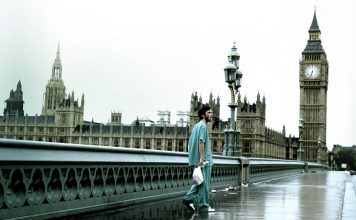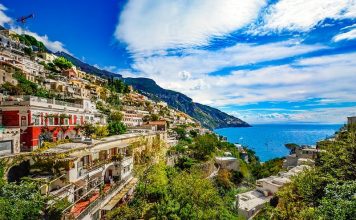While not as famous as those of Italy or Greece, Great Britain also have a great number of sculptures! Below you’ll find the most beautiful sculptures one can find while visiting Great Britain.
Robert Burns
Artist: John Flaxman
Medium: Marble
Location: Scottish National Portrait Gallery, Edinburgh
Created: 1824
Robert Burns was a Scottish poet and lyricist who was born on January 25, 1759 in Alloway (west coast of Scotland). Therefore, this celebration takes place every year on the day of his birth. He grew up in a humble family that was dedicated to agriculture, but his father, William Burns and his mother, Agnes Brown, ensured that their son received a good education, which was not extremely common at the time or in the zone. The sculpture can now be found in the Scottish National Portrait Gallery.
Bust of Ramses II
Artist: Unknown
Medium: Granite
Location: The British Museum, London
Created: 1270 BC
The bust of Ramses II, known as Ramses the Great, is one of the fragments of a statue that was found in the temple of Thebes. Ramses II was the main pharaoh who was in the greatest splendor of Ancient Egypt. It was delivered to the British museum by Napoleon Bonaparte, who delivered several of the main Egyptian pieces found in the British Museum.
Titanic Memorial
Artist: Thomas Brock
Medium: Marble
Location: City Hall Garden, Belfast
Created: 1920
In the huge square, made up of several small French-style gardens upholstered with lawns, there are some statues, including one of Queen Victoria, by Sir Thomas Brock, and another of Sir Edward Harland (also by Sir Thomas Brock), founder of the Harland & Wolff shipyard, where the RMS Titanic was built. The grounds are also home to Northern Ireland’s main war memorial, the Garden of Remembrance and the Cenotaph on which wreaths are placed on Remembrance Day. There is also a granite column dedicated to the American Expeditionary Force. In Donegal Square East stands the Titanic Memorial, commemorating the victims of the 1912 tragedy.
Colossal Head of Amenhotep III
Artist: Unknown
Medium: Granite
Location: The British Museum, London
Created: 1370 BC
The colossal head of Amenhotep III is dated to 1,350 BC. It belongs to the ninth pharaoh of the 18th dynasty of Egypt. It was found by the British consul, Henry Salt, in 1835. The place where it was found was the temple of Mut in Karnak, near Luxor (Egypt). It is undoubtedly a piece that reflects the prosperity of the pharaoh and of which it belonged to a huge statue of more than 280 meters tall.
The Monument of the Nereids
Artist: Arbinas
Medium: Marble
Location: The British Museum, London
Created: 400 BC – 380 BC
The work mixes sculpture and architecture and belongs to the Greek style. It is the entrance to a tomb. But it is the largest and most valuable ever found. It is dated between 410 and 400 BC and it was built under the command of the Lycian king Arbinas. It was found by archaeologist Charles Fellows and sent to England in 1844.
Moai Hoa Hakananai’a
Artist: Unknown
Medium: Flow lava
Location: The British Museum, London
Created: 1000 – 1600 AD
The American side is also welcomed in the British Museum. The Hoa Hakananai’a moai is the most important outside the Chilean territories. It has been in the museum since 1868. It was found that it was stolen by the English when they arrived in Chile and since then, the judicial procedures to find out who is the real owner of the figure continue to be carried out. In fact, Chileans continue to claim the power of this element, since it was created in their territories.
The Elgin Marbles
Artist: Phidias
Medium: Marble
Location: The British Museum, London
Created: 447 – 438 BCE
They are undoubtedly the most valuable Greek pieces. The Elgin marbles are those belonging to the Parthenon in Athens. Due to its many and many destructions and wars, the archaeologist Thomas Bruce, decided to collect the Greek mythological scenes that were on the facade of the Parthenon so that they would not suffer more damage. The friezes found in the museum account for a total of 40% of the Parthenon friezes. Bruce was commissioned to remove the friezes from the Greek building, but there are still differences between Greece and England over the power of such historical elements.
Hodge the Cat
Artist: Jon Bickley
Medium: Bronze
Location: Gough Square, London
Created: 1997
Hodge was a famous cat to whom the writer Percival Stockdale dedicated an ode when he died. It belonged to Samuel Johnson, the author of the first dictionary of the English language, published in 1755. Apparently, Dr. Johnson was personally in charge of buying oysters for Hodge. In 1997, the City of London commissioned a statue of Hodge from sculptor Jon Bickley to be placed in Gough Square, in front of the house where he lived.
Millicent Fawcett
Artist: Gillian Wearing
Medium: Bronze
Location: Parliament Square, London
Created: 2018
London pays tribute to Millicent Fawcett with a statue in the Parliament Square. The suffragette Millicent Fawcett (Aldeburgh, Suffolk, 1847 – London, 1929) has won a place in front of the British Parliament. Of course, a century after the right to vote was achieved in the United Kingdom.
Another Place
Artist: Antony Gormley
Medium: Cast Iron
Location: Crosby Beach, Merseyside
Created: 2005
Another Place is an artistic project, a modern sculpture, installed on the beach at Crosby Beach, about 20 kilometers from the center of Liverpool. This work was created as a traveling exhibition that intended to go around the world, visiting large cities. After passing through Norway, Germany and Belgium, Antony Gormley’s work reached the United Kingdom. The idea was for “Another Place” to stay in Liverpool for only a few months before heading to its next destination, New York.
Marquess of Anglesey’s Column
Artist: Thomas Harrison
Medium: Limestone
Location: Anglesey, Wales
Created: 1816
The Marquess of Anglesey Column is a 27 meter high limestone pillar built in 1816 to honor the Marquis, Henry Paget. The tribute to this character was due to the loss of his leg in the battle of Waterloo, and the person in charge of designing the column was Thomas Harrison, who also designed the Holyhead arch.


























